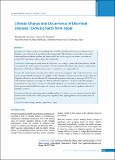Please use this identifier to cite or link to this item:
https://hdl.handle.net/20.500.14356/1936Full metadata record
| DC Field | Value | Language |
|---|---|---|
| dc.contributor.author | Bhandari, G P | - |
| dc.contributor.author | Gurung, S | - |
| dc.contributor.author | Dhimal, M | - |
| dc.contributor.author | Bhusal, C L | - |
| dc.date.accessioned | 2023-06-02T05:14:15Z | - |
| dc.date.available | 2023-06-02T05:14:15Z | - |
| dc.date.issued | 2012 | - |
| dc.identifier.citation | BhandariG., GurungS., DhimalM., & BhusalC. L. (2013). Climate Change and Occurrence of Diarrheal Diseases: Evolving Facts from Nepal. Journal of Nepal Health Research Council. https://doi.org/10.33314/jnhrc.v0i0.328 | en_US |
| dc.identifier.issn | Print ISSN: 1727-5482; Online ISSN: 1999-6217 | - |
| dc.identifier.uri | http://103.69.126.140:8080/handle/20.500.14356/1936 | - |
| dc.description | Original Article | en_US |
| dc.description.abstract | Abstract Background: Climate change is becoming huge threat to health especially for those from developing countries. Diarrhea as one of the major diseases linked with changing climate. This study has been carried out to assess the relationship between climatic variables, and malaria and to find out the range of non-climatic factors that can confound the relationship of climate change and human health. Methods: It is a Retrospective study where data of past ten years relating to climate and disease (diarrhea) variable were analyzed. The study conducted trend analysis based on correlation. The climate related data were obtained from Department of Hydrology and Meteorology. Time Series analysis was also being conducted. Results: The trend of number of yearly cases of diarrhea has been increasing from 1998 to 2001 after which the cases remain constant till 2006.The climate types in Jhapa vary from humid to per-humid based on the moisture index and Mega-thermal based on thermal efficiency. The mean annual temperature is increasing at an average of 0.04 °C/year with maximum temperature increasing faster than the minimum temperature. The annual total rainfall of Jhapa is decreasing at an average rate of -7.1 mm/year. Statistically significant correlation between diarrheal cases occurrence and temperature and rainfall has been observed. However, climate variables were not the significant predictors of diarrheal occurrence. Conclusions: The association among climate variables and diarrheal disease occurrence cannot be neglected which has been showed by this study. Further prospective longitudinal study adjusting influence of non-climatic factors is recommended. Keywords:climate change; diarrhea; Jhapa district; Nepal. | en_US |
| dc.language.iso | en | en_US |
| dc.publisher | Nepal Health Research Council | en_US |
| dc.relation.ispartofseries | Sep-Dec, 2012;328 | - |
| dc.subject | Climate change | en_US |
| dc.subject | Diarrhea | en_US |
| dc.subject | Jhapa district | en_US |
| dc.subject | Nepal | en_US |
| dc.title | Climate Change and Occurrence of Diarrheal Diseases: Evolving Facts from Nepal | en_US |
| dc.type | Journal Article | en_US |
| local.journal.category | Original Article | - |
| Appears in Collections: | Vol. 10 No. 3 Issue 22 Sep - Dec, 2012 | |
Files in This Item:
| File | Description | Size | Format | |
|---|---|---|---|---|
| 328-Article Text-327-1-10-20130823.pdf | Fulltext Download | 571.49 kB | Adobe PDF |  View/Open |
Items in DSpace are protected by copyright, with all rights reserved, unless otherwise indicated.
